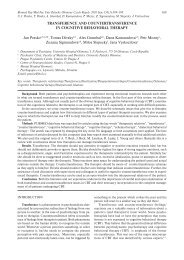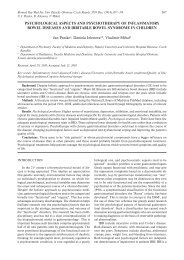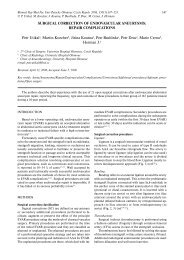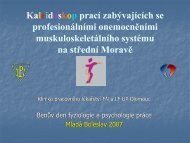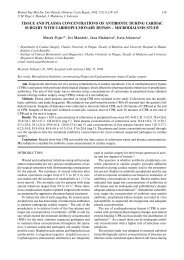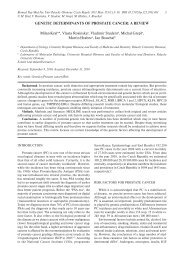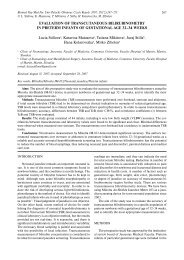APPROACHES TO MESSENGER RNA DETECTION - ResearchGate
APPROACHES TO MESSENGER RNA DETECTION - ResearchGate
APPROACHES TO MESSENGER RNA DETECTION - ResearchGate
You also want an ePaper? Increase the reach of your titles
YUMPU automatically turns print PDFs into web optimized ePapers that Google loves.
134 Z. Dvořák, J.-M. Pascussi, M. ModrianskýSWOT: Strength: Owing to its unique principle, themethod gives nearly absolute specificity. It is therefore themost specific from the three methods under review 6 . Consequently,the design of the probe is intended to recognizea specific sequence like in other techniques. Compared tothe NB, RPA is approximately ten times more sensitive.Weakness: The method is time consuming and requiresa highly skilled operator. The work organisation is verytiresome for the operator because there is no chance forpostponing any of the steps after hybridization. Furthermore,economical expenses are higher as compared toNB. Opportunity: Due to its high specificity, two or severalgenes with high homology in primary structure can be distinguished.Recall again that only one base pair mismatchleads to the cleavage by <strong>RNA</strong>ses. Threat: Since the procedureconsists of many steps, the risk of <strong>RNA</strong> degradationin sample during the analysis is very high and occursquite frequently. The risk of radioactivity contaminationwhen handling samples and particularly during riboprobepreparation is also considerable, even though the activitiesused are much lower than in the NB method.REAL TIME POLYMERASE CHAIN REACTIONThanks to its sensitivity even very low abundancem<strong>RNA</strong> can be detected using this technique. Other frequentuses include: primary validation of gene expressionand hence confirmation of microarray data, splice variantanalysis, allelic discrimination, viral titre (e.g. HCV),bacterial species identification, and single nucleotidepolymorphism genotyping.Method description: This method takes an advantagefrom well known polymerase chain reaction (PCR)which is used for DNA detection 7 . The abbreviation RT-is somewhat ambiguous standing on one hand for reversetranscription reaction, a key step in the procedure, and onthe other hand for real time format of the analysis whenLightcycler apparatus is used 8 .First of all, the reverse transcription reaction is performedusing <strong>RNA</strong>-dependent DNA polymerase (reversetranscriptase), synthesising the cDNAs complementaryto the m<strong>RNA</strong>s present in the sample. It is sine qua nonto use sample of <strong>RNA</strong> in water free of organic solventsresidues, e.g. phenol, isopropanol, chloroform, ethanoletc., to avoid inhibition of reverse transcriptase. Forthe starting material it is possible to use total <strong>RNA</strong>, atleast 1 µg, but isolated m<strong>RNA</strong> is more appropriate givinghigher probability of low copy m<strong>RNA</strong> transcription.The synthesised cDNA is mixed with DNA-dependentDNA polymerase, sufficient amount of deoxynucleotidetriphosphates (dATP, dCTP, dGTP, and dTTP), andfluorescently labeled oligonucleotide primers. As in thecase of “classical” PCR, one cycle of a PCR reactionconsists of strand separation, annealing, and elongationsteps. Duration of and temperature during each of thethree steps are set on the thermocycler apparatus in use.Fluorescence is monitored in each sample following everycycle of the PCR reaction. When threshold fluorescenceintensity is reached due to increased number of copies ofthe cDNA of interest, the fluorescence linearly increasesin each Asubsequent cycle eventually reaching a maximumplateau. The threshold RIF (M) is so-called Actin“crossing CYP3A4 point” whichis essential for comparison between samples. Computersoftware provided0with the Lightcycler14.69usually27.84calculatesthe cycle number 1corresponding 14.86to the crossing 22.94 point usingsecond derivative 5 maximum. 15.07If calibrated 22.24for knownnumber of cDNA copies present in a sample, RT-PCR canbe used for very precise 10 quantification 14.78 of 21.56 original m<strong>RNA</strong>copies per number 20 of cells 8, 15.319 . Representative 21.52computeroutput from a Lightcycler apparatus is shown in Fig 3.ARIF (M)0151020Actin14.6914.8615.0714.7815.31CYP3A427.8422.9422.2421.5621.52BFlod inductionnormalized per actinInduction of CYP3A4 by rifampicin1501005000 1 5 10 20Rifampicin (M)Fig. 3. Example of Real-Time Polymerase Chain Reaction analysis. RT-PCR computer data from total <strong>RNA</strong> isolated fromB primary Induction human hepatocytes of CYP3A4 by using rifampicin Trizol procedure. Panel A) shows cycle thresholds for CYP3A4 and actin m<strong>RNA</strong>.Panel B) 150shows fold induction of CYP3A4 gene by rifampicin. Data are normalized per actin value.Flod inductionnormalized per actin1005000 1 5 10 20Rifampicin (M)




